The Huawei MateBook 16 Review, Powered by AMD Ryzen 7 5800H: Ecosystem Plus
by Dr. Ian Cutress on October 20, 2021 8:00 AM EST- Posted in
- Laptops
- AMD
- Huawei
- Matebook
- Ryzen
- Zen 3
- MateBook 16
- Huawei Share
- Ryzen 7 5800H
Display, Battery Life, and Charging
The Monitor
The high-level specifications of the monitor make for very interesting reading. A 16-inch IPS display with a 2520x1680 resolution, making it a 3:2 ratio (which is becoming more and more common on laptops of all sizes). The IPS panel means that the viewing angles are wide, and Huawei rates the screen for 300 nits brightness maximum as well as a 1500:1 contrast ratio. That brightness maximum isn’t anything to write home about – in fact it’s a bit low for any external daytime use – but the contrast ratio is better than the MateBook X Pro we last reviewed because of the lower blacks. On colors, Huawei pre-calibrates the display to a dE below 1, qualifying the display for 100% of the sRGB gamut with 8-bit + FRC support.
That gives a lot to play with, so here are our results:
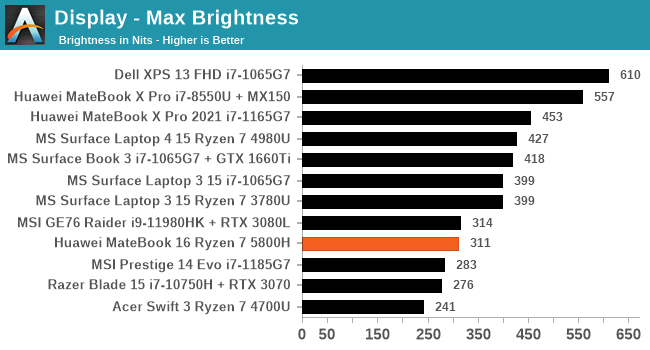
The specification sheet said 300 nits, and we scored 311. Our 200 nits regular battery testing was at a brightness setting of 65, with a very linear profile sweep.
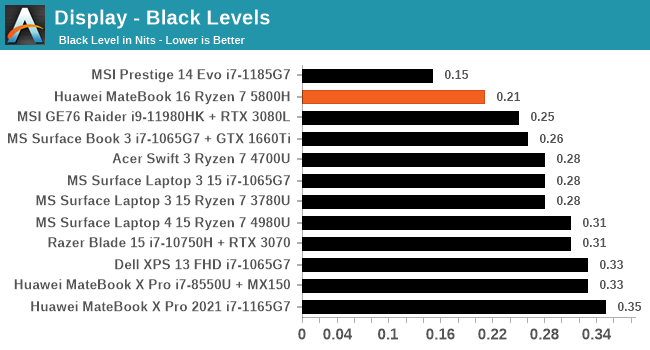

The display has some of the better black levels at maximum brightness that we’ve tested, giving a 1488:1 contrast ratio, which is almost identical to the rating.
The odd resolution of 2520x1680 is a little left-field: Huawei calls it a 2.5K+ display. But what it really comes down to is the 3:2 version of 2560x1600, which is a 16:10 ratio. The only thing really missing from the display is the lack of a touchscreen. For certain office workloads, having a touchscreen is quite handy, although it does tend to add a little weight.
For those looking for color accuracy, unfortunately I do not have the same equipment Brett does for this, however my colorimeter provides the following at 200 nits:
This shows that the red tracking is almost perfect, with the greens and the blues being biased away from that proportional line.
Battery Life
Due to the short time we had, I was only able to run one battery life test, and chose our Web Playback test that uses MS Edge to cycle through a number of remote server-driven but fixed webpage workloads. The screen brightness is set to 200 nits. Power numbers are reverse calculated mWh reported by Windows.
After the initial caching of the webpages, the system settled down into a 6-8 for most of the test. At around 550 minutes, we see a decrease in the system activity, which we’re attributing to the system entering the low power plan at 20% total battery, which surprisingly picks up again after an hour around 15% battery. The total battery life in this case, from 100% charge to shutdown (which this laptop was set at 2%, but Windows cuts at 2.5%) is 697 minutes.
Charging
So here’s where it gets a bit interesting. The laptop has a 35W/45W processor, an 84 Wh battery, and a 135 W power charger. The performance mode can only be accessed when the charger is equipped. But in a charging scenario, we get three different variants:
- When the system is idle, it will charge the battery at around 35 W and draw 50 W at the wall.
- If the display is closed, regardless of the sleep state, the battery will charge at 70 W and draw 70-90 W at the wall.
- Only when performance mode is active, and the CPU is being used fully, does the charger draw its full 135W setting.
One of the key features of this unit is the fast charging and the bundled 135 W charger. But users should note that it never charges at 135 W, but it will draw that much at the wall when the system is in use under a high-performance load. We did charging runs for both the first and second modes, with the display set to 200 nits but otherwise the system was idle.
In the 70W charging mode, the system charges at 70 W for 42 minutes, before dropping to 60 W for 8 minutes, then trickling down until ~82 minutes where it ramps up again for a seemingly final push. In this mode, we get the following:
- 10 minutes charge gets from 1696 to 13466 mWh (15.8%)
- 30 minutes charge gets from 1696 to 36374 mWh (42.8%)
- 90% charge takes 71.3 minutes
When we move down to the 35W mode, while the system is in the default Balanced CPU mode rather than Performance CPU mode, it takes a lot longer:
Here we start with an initial power wobble (for whatever reason this laptop doesn’t like accurately refreshing its battery power below 5%), and then get a constant 35 W battery charge until 90%, then it switches charging modes until 95%, and the PMIC increases charging again. In this mode, we get the following:
- 10 minutes charge gets from 1662 to 5925 mWh (7.1%)
- 30 minutes charge gets from 1662 to 17408 mWh (20.9%)
- 90% charge takes 130.2 minutes
I can certainly see the reason for having a slower charge while the lid is up – if there would be a thermal build-up on charging, the lid up means that while the laptop is in use, and so the user is not affected. It also gives room for when the system needs to go full bore. The downside is knowing that shutting the lid doubles the charging rate, so if you need a quick charge before going somewhere, it’s going to be beneficial to close the laptop lid and wait, unable to use the device, than to continue charging and working.

It should be noted that when our review unit arrived, the 135 W charger was effectively DoA; a second one arrived the day before our review embargo lifted (I unfortunately went on holiday, so this review was completed after I returned). That second charger has worked flawlessly, so I can only assume we had a (rare) dud charger. During the interim, I had other Huawei 65 W chargers from other products around for testing, and those worked without issue.


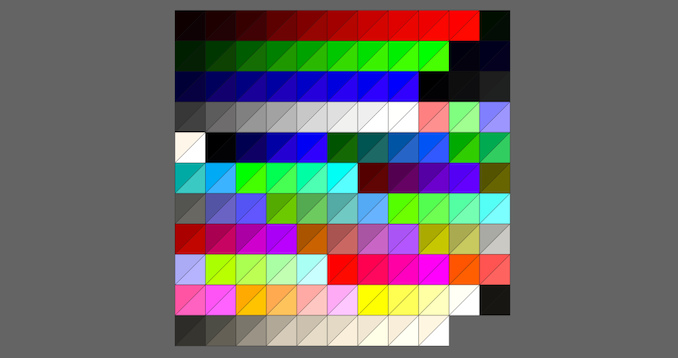
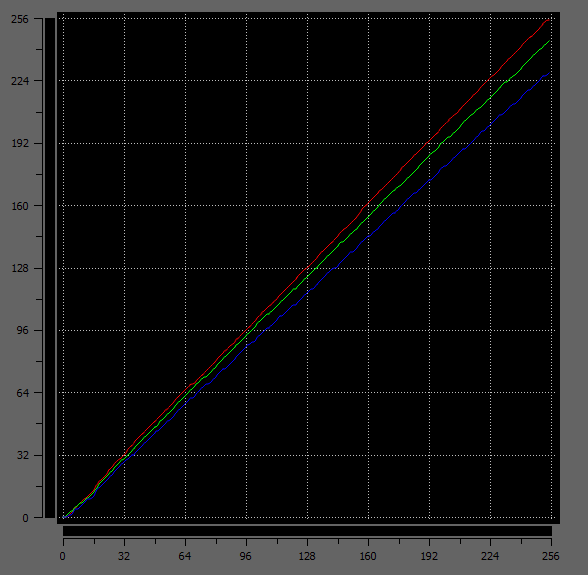
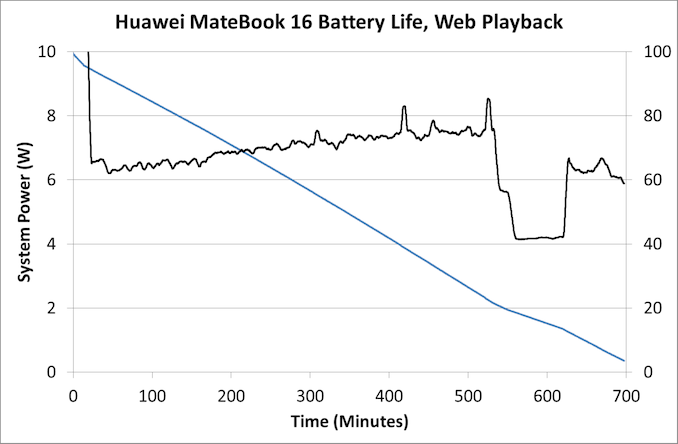

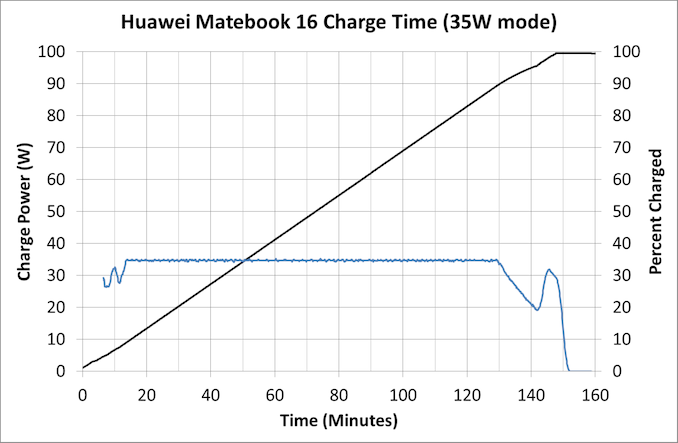








87 Comments
View All Comments
Samus - Wednesday, October 20, 2021 - link
Every notebook I've ever had with a dGPU has been useless for portability. It isn't that they are bulky or heavy anymore, that issue has been overcome, even though they still run hot.But they get terrible battery life whether using the dGPU or not - the battery is physically tiny to make room for all the shit they cram into it.
My last two notebooks have been iGPU Intel's but now that we have companies considering additional headroom on the Ryzen GPU that would likely beat anything Intel has.
Prestissimo - Thursday, October 21, 2021 - link
Spend more money on laptops with 90-100WHr Battery + non-4K Screen + Ryzen 5000H/HS CPUs, and you'll find that they are lightweight, portable, cool on idle, and have excellent 7-8 hour battery life.You get what you pay for.
EasyListening - Friday, October 22, 2021 - link
AMD's partnership with TSMC puts it at the head of the pack in electrical efficiency. TSMC's manufacturing technology is superior to Intel's and Samsung's. Intel is still struggling with 10nm, and Nvidia screwed itself by ticking TSMC off (tried to pressure them on pricing), leaving it no option but to go with Samsung and it's poor yields, and that much, everyone knows. What might not be obvious is that AMD put together a dream team to launch Lisa Su's tenure as CEO. Papermaster would have known Su at IBM (she was head of research). Jim Keller and Raja Koduri are both former AMD. The three of them were at Apple, making the iPhone 4. They probably trained the team that produced the M1. Koduri is now at Intel, and Papermaster is still at AMD. Keller is doing his thing, blowing minds wherever he goes. AMD is not inferior, it is just much smaller. With TSMC's help, AMD might look like a behemoth, but actually, it's more like a boutique chip design shop. And Su is a genius who should have won a Nobel Prize for her pioneering work on silicon doping (made it possible to use copper instead of aluminum traces in semiconductors). Her PhD from MIT is in semiconductor manufacturing. Intel may be bigger, but AMD punches way above it's weight class. It's simply an amazing company, and we can all expect nothing but the best from them going forward. The turnaround of AMD is the best tech story of this era.lemurbutton - Wednesday, October 20, 2021 - link
Another laptop review without industry-leading Macbooks. Come on Anandtech.The_Assimilator - Wednesday, October 20, 2021 - link
That's because it's a review, not a comparison, Captain Genius.hlovatt - Wednesday, October 20, 2021 - link
But it does compare to other laptops in the performance tables. So why not include MBA and it’s M1 processor. It would be very interesting to see how they stack up.dontlistentome - Wednesday, October 20, 2021 - link
It compares if you're running Chrome or a benchmark set. MS Excel models or a ton of other stuff? Not so much.philehidiot - Wednesday, October 20, 2021 - link
The price disparity means they're in different ballparks. I like my Mac and it's OS. But I'm not looking for a new one at the price their decent systems come in at.lemurbutton - Thursday, October 21, 2021 - link
M1 Macbook Air is $850 on sale frequently.fishingbait15 - Friday, October 22, 2021 - link
That $850-$1000 M1 MacBook Air has a 13' screen, 8 GB RAM, 256 GB storage, has 1/8 of its GPU cores disabled for no particular reason and only supports 1 external monitor. Even if you leave aside the massive amount of Windows-only and x86-only software AND its complete and total lack of upgradability - it doesn't even support an eGPU despite having a Thunderbolt 4 port - there are tons of reasons not to consider the M1 MacBook Air a relevant comparison. Yes, it runs slightly faster but it is an entry level device. This isn't. You would need to compare it to the 13' MacBook Pro ... which costs a couple hundred more yet still has many of the same downsides (all the GPU cores work on it at least).